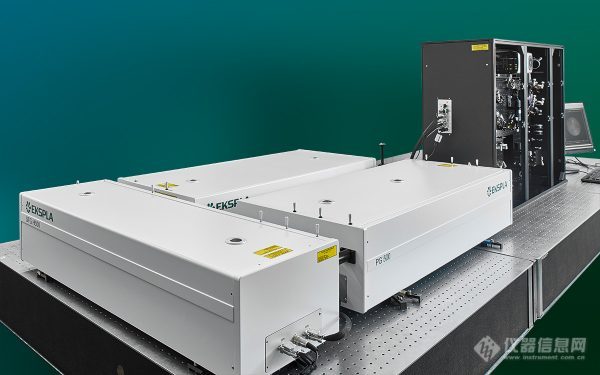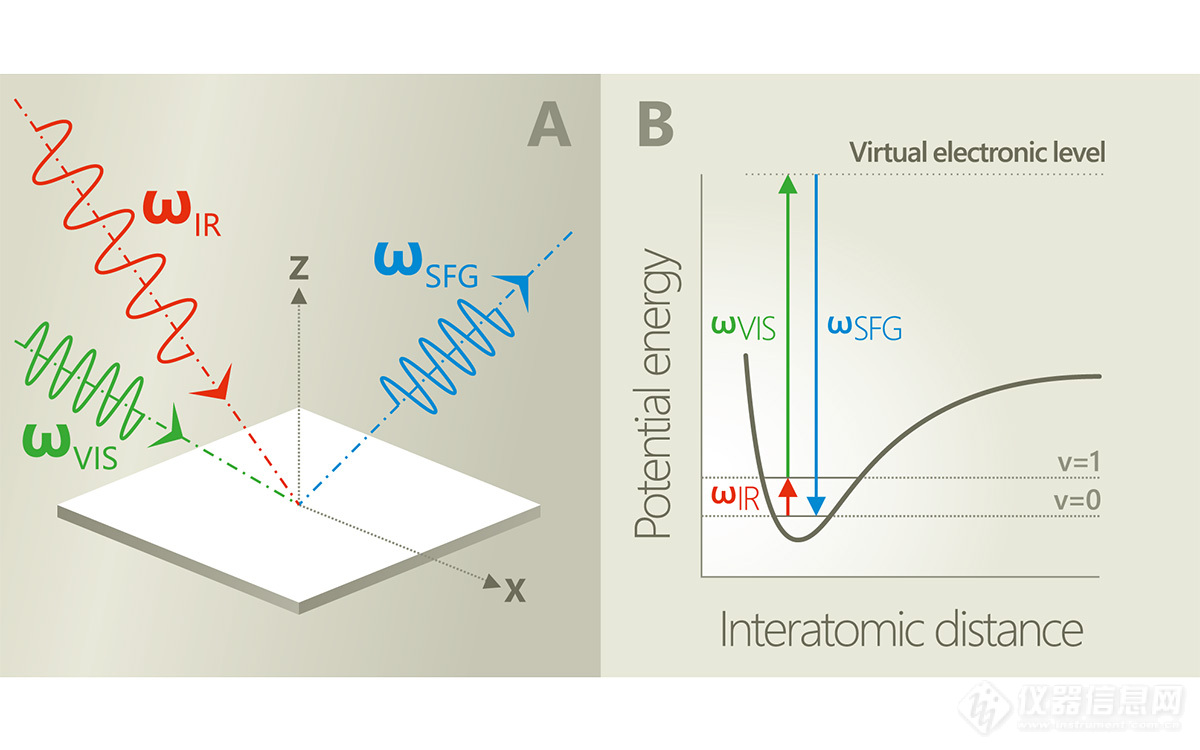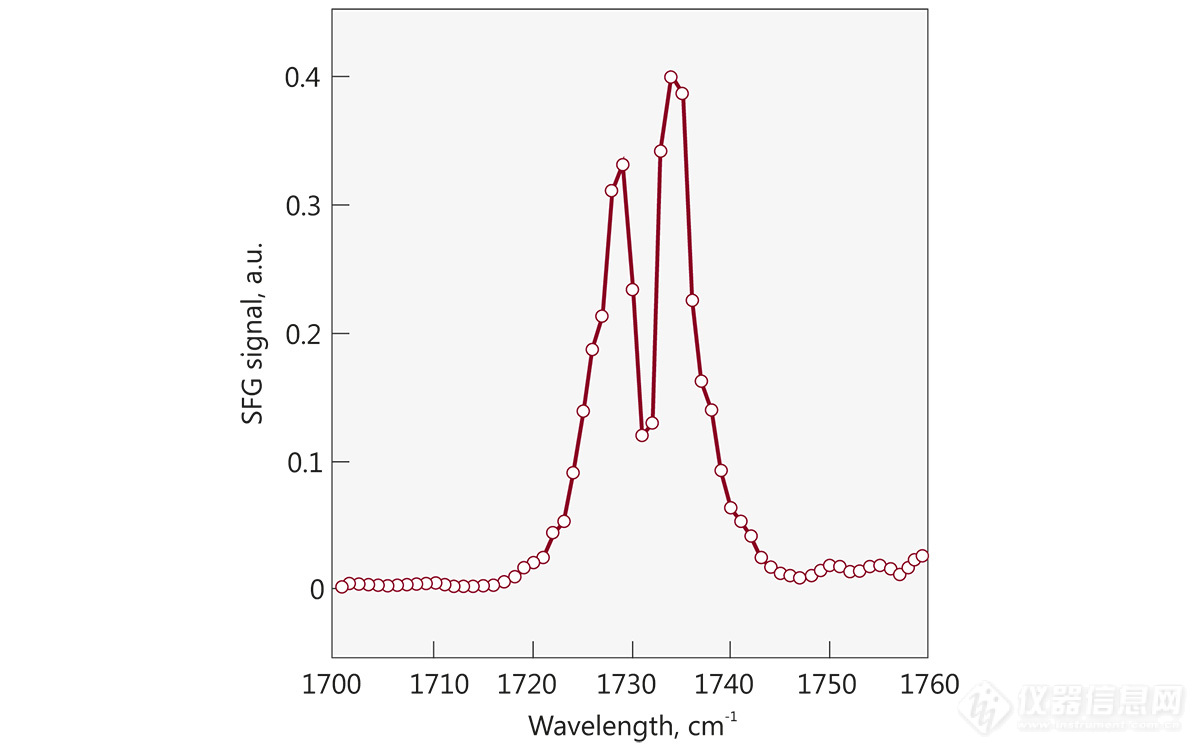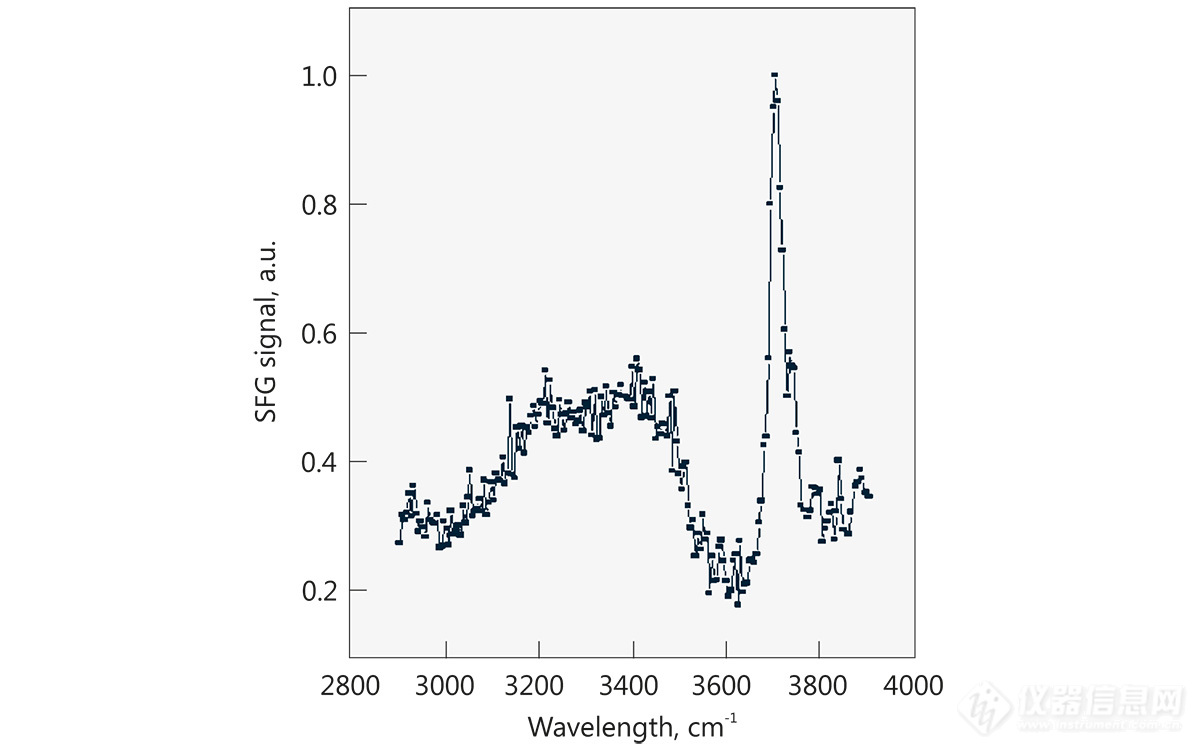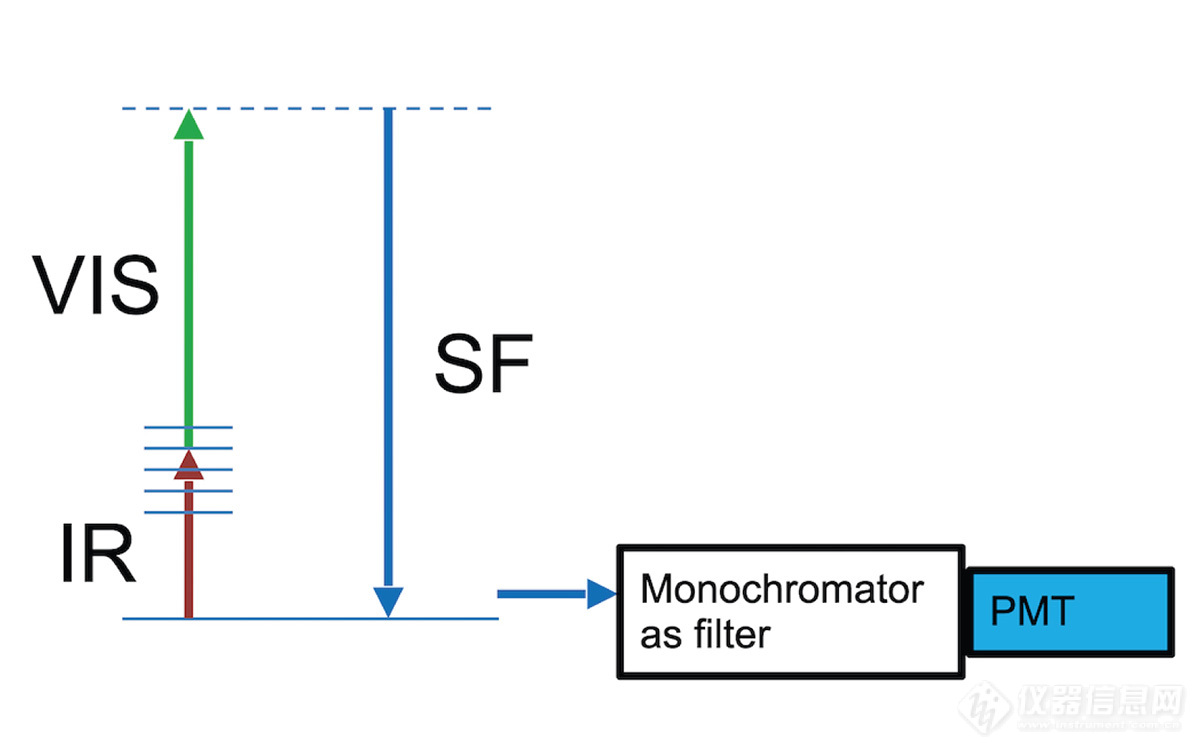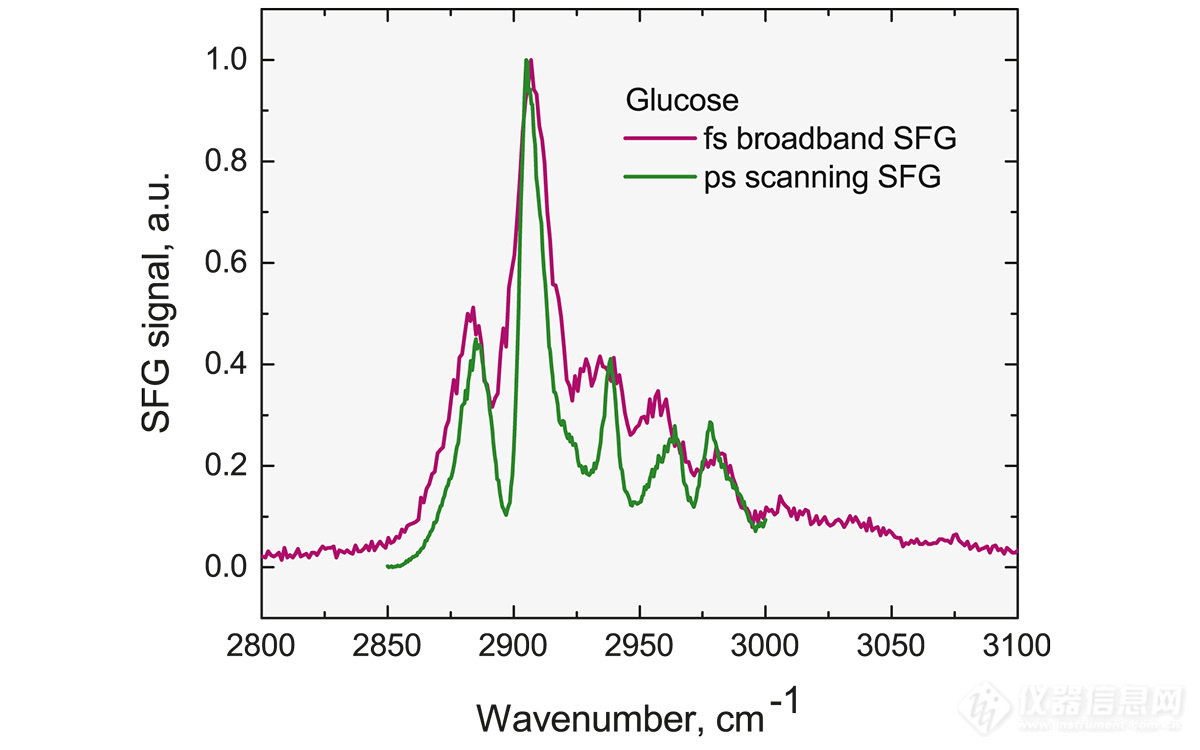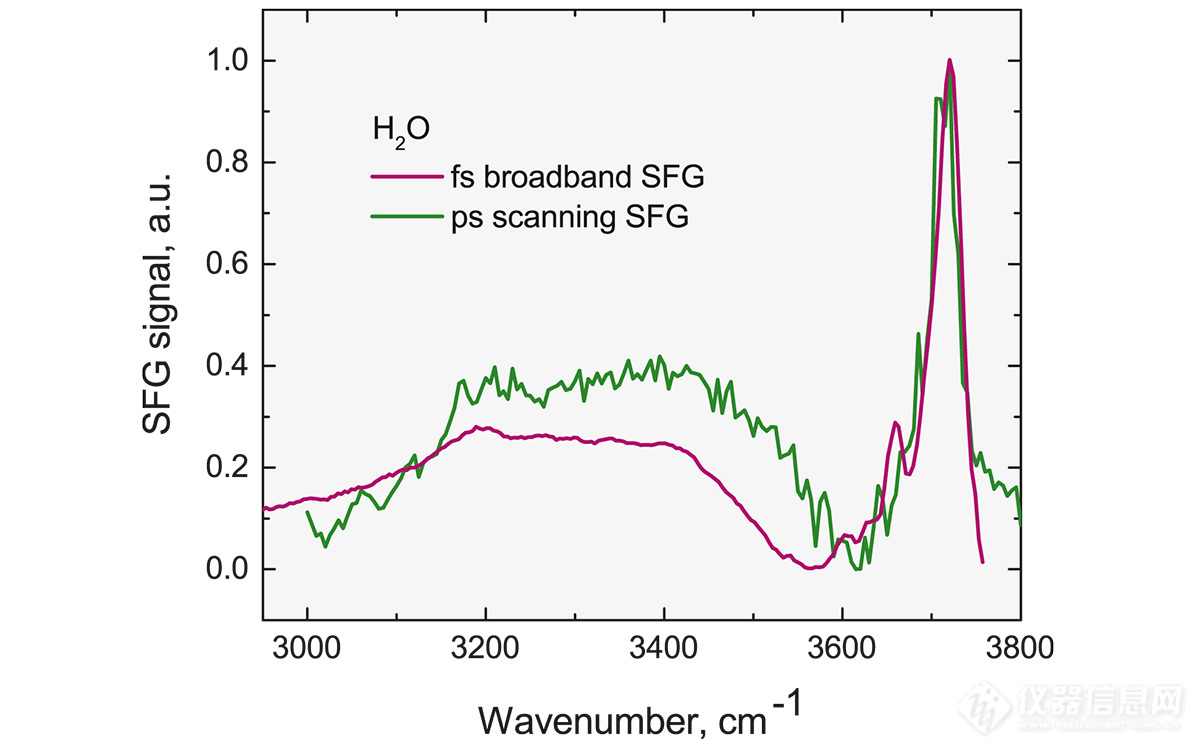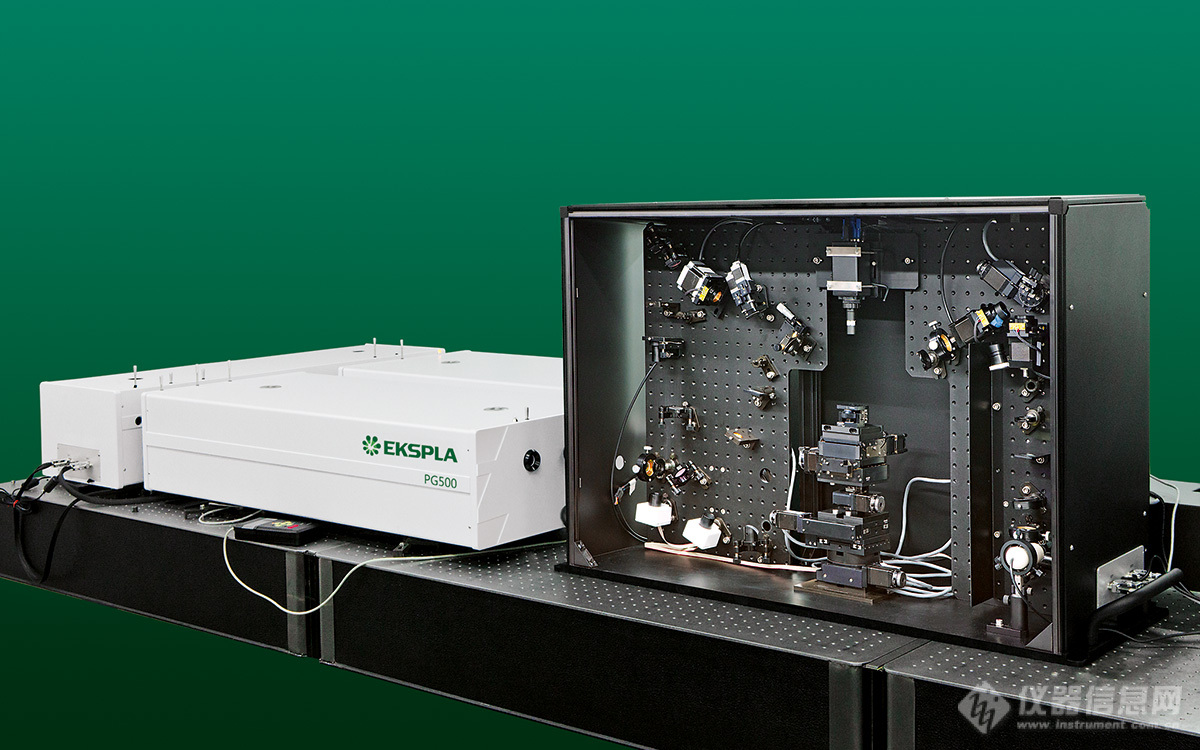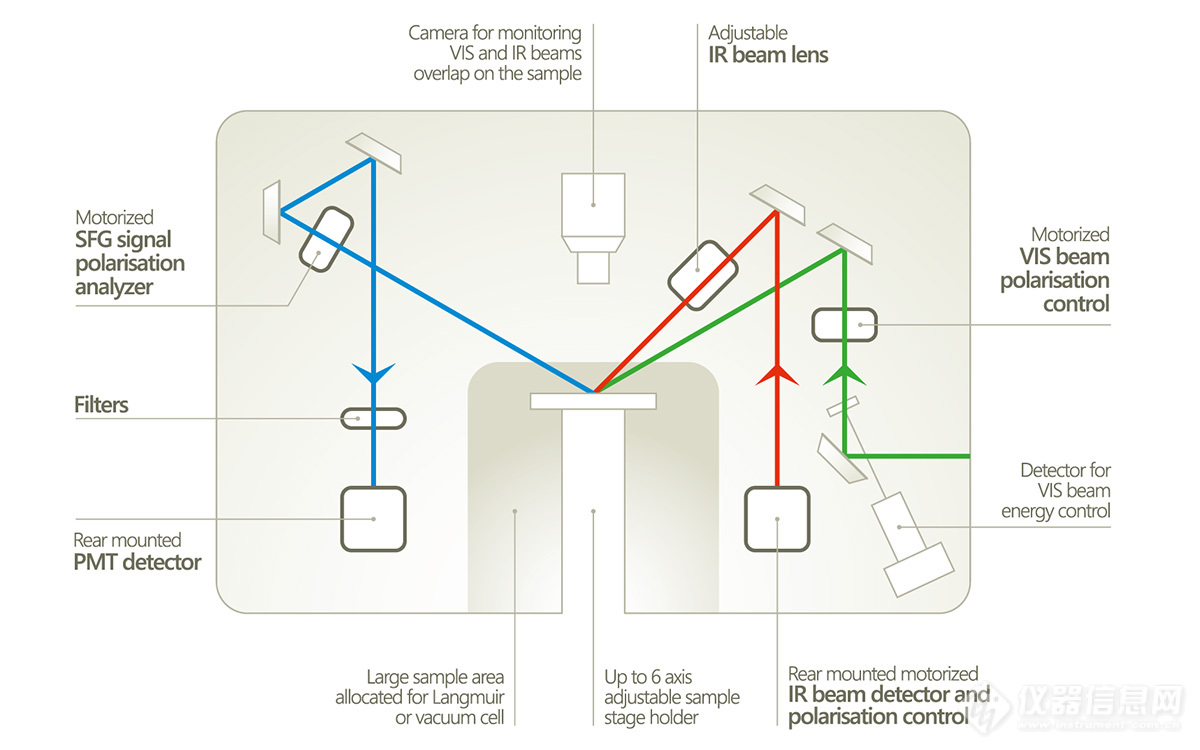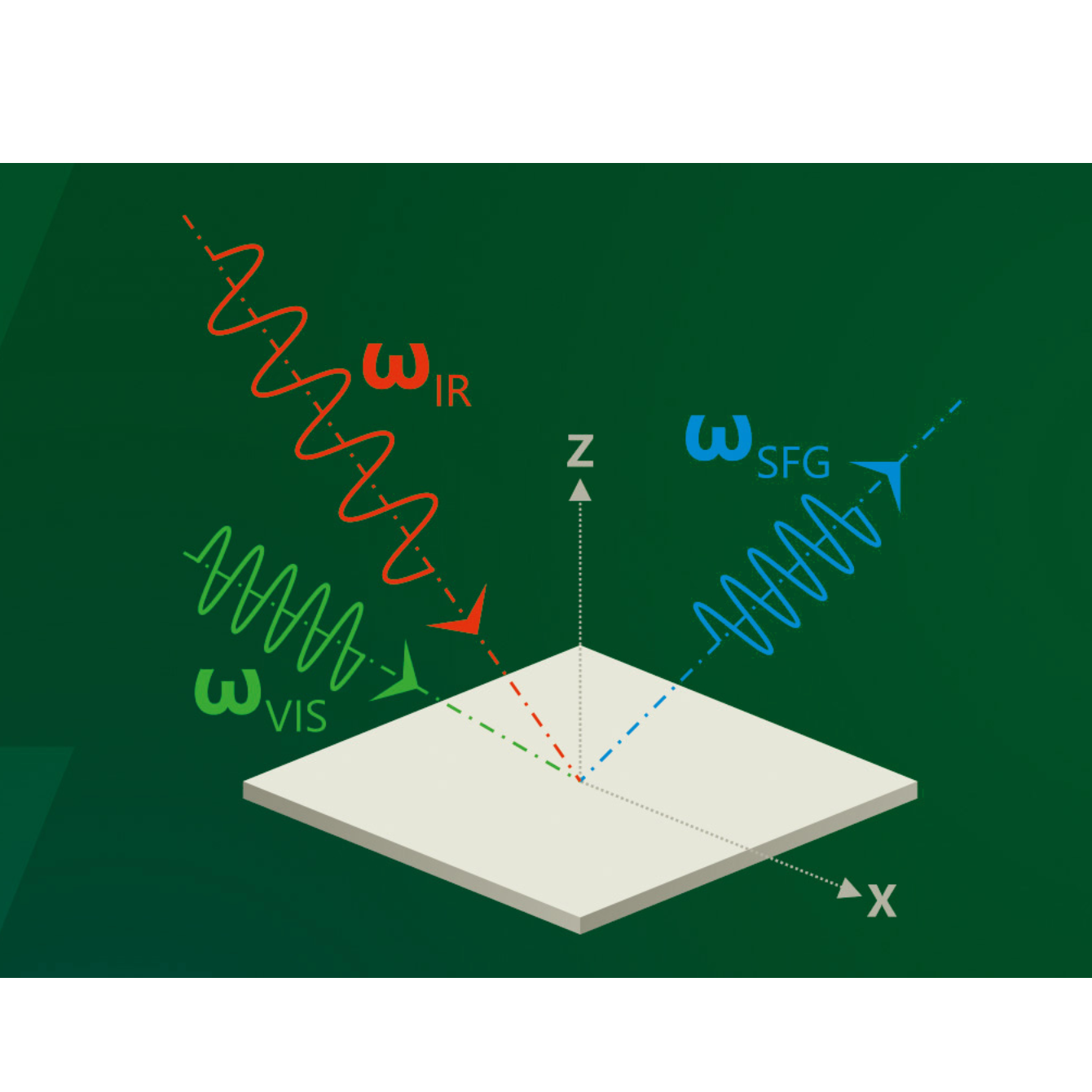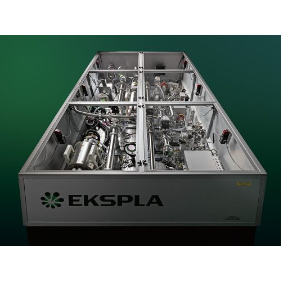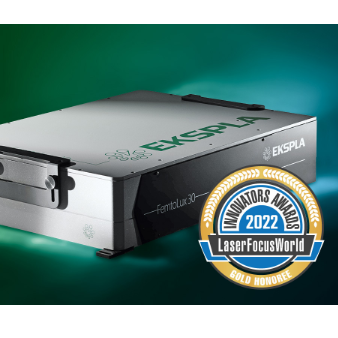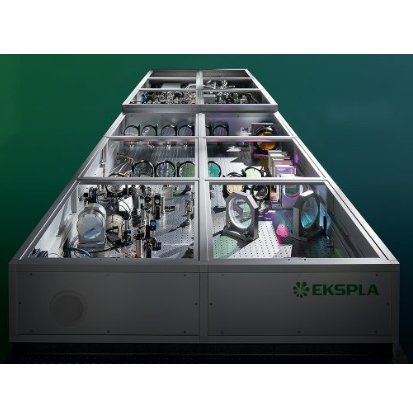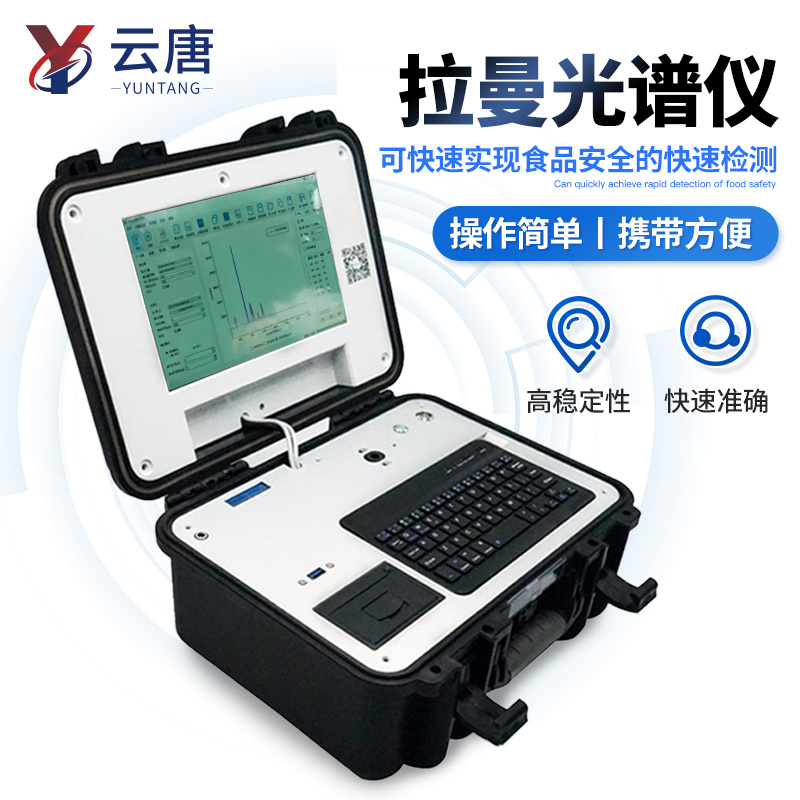Scanning SFG Spectrometer
datasheet

Characterisation of vibrational bonds of molecules at surfaces or interfaces
Intrinsically surface specific
High spectral resolution
Wide range of accessible (molecular) vibrations: 625 – 4300 cm⁻¹
Sum Frequency Generation (SFG) Vibrational Spectroscopy
ADVANTAGES
Sensitive and selective to the orientation of molecules in the surface layer
Intrinsically surface specific
Selective to adsorbed species
Sensitive to submonolayer of molecules
Applicable to all interfaces accessible to light
Nondestructive
Capable of high spectral and spatial resolution
APPLICATIONS
Investigation of surfaces and interfaces of solids, liquids, polymers, biological membranes and other systems
Studies of surface structure, chemical composition and molecular orientation
Remote sensing in hostile environment
Investigation of surface reactions under real atmosphere, catalysis, surface dynamics
Studies of epitaxial growth, electrochemistry, material and environmental problems
Sum Frequency Generation Vibrational Spectroscopy (SFG-VS) is powerful and versatile method for in-situ investigation of surfaces and interfaces. In SFG-VS experiment a pulsed tunable infrared IR (ωIR) laser beam is mixed with a visible VIS (ωVIS) beam to produce an output at the sum frequency (ωSFG = ωIR + ωVIS). SFG is second order nonlinear process, which is allowed only in media without inversion symmetry. At surfaces or interfaces inversion symmetry is necessarily broken, that makes SFG highly surface specific. As the IR wavelength is scanned, active vibrational modes of molecules at the interface give a resonant contribution to SF signal. The resonant enhancement provides spectral information on surface characteristic vibrational transitions.
Vibrational sum frequency generation (SFG) spectroscopy holds several important advantages over traditional spectroscopy methods for the molecular level analysis of interfaces, including (i) surface sensitivity, (ii) vibrational specificity, and (iii) the possibility to extract detailed information on the ordering and orientation of molecular groups at the interface by analysis of polarization-dependent SFG spectra.
Comparison of Narrowband and Broadband SFG Spectrometers
NARROWBAND PICOSECOND SCANNING SFG SPECTROMETER
In order to get SFG spectrum during measurement wavelength of narrowband mid-IR pulse is changed point-by-point throughout the range of interest. Narrowband SFG signal is recorded by the time-gated photomultiplier. Energy of each mid-IR, VIS and SFG pulse is measured. After the measurement, the SFG spectrum can be normalised according to IR and VIS energy. Spectral resolution is determined by the bandwidth of the mid-IR light source. The narrower mid-IR pulse bandwidth, the better the SFG spectral resolution. Separate vibrational modes are excited during the measurement.
BROADBAND FEMTOSECOND SFG SPECTROMETER
A broadband mid-IR pulse is mixed with a narrowband VIS pulse. The result is broadband SFG spectrum which is recorded using a monochromator and a sensitive CCD camera. The full spectrum is acquired simultaneously by integrating signal over time. Spectral resolution is determined by the bandwidth of the VIS pulse and on the monochromator-camera combination. The narrower the bandwidth of VIS pulse, the better the SFG spectral resolution.
COMPARISON OF DIFFERENT SFG SPECTROMETRES
Features and Design
The SFG spectrometer developed by Ekspla engineers is a nonlinear spectrometry instrument, convenient for everyday use. Ekspla manufactures SFG spectrometers, which are used by chemists, biologists, material scientists, and physicists. The spectrometer has many features that help to set up measurements and to make successful vibrational spectroscopy studies. For chemical and biochemical laboratories, this makes the Ekspla SFG spectrometer a reliable workhorse with a broad spectral region, automatically tuned from 1,000 to 4,300 cm-1, a high spectral resolution (2 or 6 cm-1), and easily controlled adjustment of polarisation optics.
The Ekspla SFG system is based on a mode-locked Nd:YAG laser with a 29 ps pulse duration, with 30 – 40 mJ pulse energy at 1,064 nm and a 50 Hz repetition rate. The VIS channel of the SFG spectrometer consists of part of a laser output beam, usually with doubled frequency (532 nm) up to 0.5 mJ. The main part of the laser radiation goes to an optical parametric generator (OPG) with a difference frequency generation (DFG) extension. The IR channel of the spectrometer is pumped by the DFG output beam with energy in the range of ~40 – 200 μJ. Infrared light can be tuned in a very broad spectral range from 2.3 up to 10 (optionaly up to 16) μm. The bandwidth is 2 or 6 cm-1 (depending on the selected OPG model) and it is one of the main factors of SFG spectrometer spectral resolution. The second beam (VIS) is also narrowband at <2 cm-1.
The spectrometer detection system has a temporal gate. It reduces noise collection and ambient light influence, which allows the spectrometer to be used even in a brightly illuminated room. The spectrometer does not have any acoustic noise because the laser is pumped by diodes. The spot size of the IR beam is adjustable. In this way, the appropriate energy density is achieved to avoid damaging the sample. Spectrum scanning, polarisation control and VIS beam attenuation are controlled from a computer. The spectrometer has a motorized polarisation switch for the IR, optionaly for the VIS, and optionaly the generated SFG light beams . Special detectors continuously monitor the energy of the VIS and mid-IR laser pulses, so IR energy is checked at each measurement point. This makes it easy to normalize the resulting SFG vibrational spectrum.
SYSTEM COMPONENTS
Picosecond mode-locked Nd:YAG laser
Multichannel beam delivery unit
Picosecond optical parametric generator
Spectroscopy module
Monochromator
PMT based signal detectors
Data acquisition system
Dedicated LabView® software package for system control
SPECTROSCOPY MODULE, SAMPLE COMPARTMENT
A large sample compartment can be customised and enables the use of various extensions and additional instruments for simultaneous control of the sample conditions, including a Langmuir-Blodgett trough for air/water and lipid/air interface studies, temperature and humidity-controlled cells, and other instruments.
SPECTRAL RANGE OF THE SFG SPECTROMETER
The spectral range of the infrared beam determines available vibrational spectra and the spectral range of the spectrometer.
The main modification of the spectrometer enables a spectral range of 1,000 to 4,300 cm-1.
SFG Spectrometer available with a shorter spectral range 2,500 to 4,300 cm-1.
SFG spectrometer with extended vibrational frequency range. Using an additional crystal in the laser light source, the range of the spectrometer expands by up to 625 cm-1. This opens a fingerprint spectral region for the analysis of many inorganic compounds, the vibrations of ions and biomolecules.
SAFETY OF THE SFG SPECTROMETER
The spectrometer is safe to use: all high energy pulsed beams are enclosed. In addition, the sample area also has a special cover. During the measurements, it is possible to close the sample compartment so that radiation cannot penetrate outside. The automatic change of polarisation and energy attenuation makes it possible to perform measurements without opening the spectrometer. Laser safety precautions are required only for the alignment of the laser beams on the studied surface.
Components & Optional Accessories
PICOSECOND MODE-LOCKED ND:YAG LASER
The heart of the spectrometer is solid-state picosecond laser. Its reliability is critical to perfect spectrometer operation and relevance of measured data. Two standard models of high energy lasers are dedicated for SFG spectrometers. Model PL2230 is fully diode pumped, which means that master oscillator and all following amplification stages are diode pumped. It features great long term parameters stability and minimal maintenance requirements.
This model provides up to 40 mJ per pulse output energy, which in most cases is enough for pumping OPG and VIS channel of SFG spectrometer. Model PL2230 is available for double resonance SFG. This model usually is used for pumping of two independent OPG’s. Such configuration is used in double resonance SFG version.
MULTICHANNEL BEAMS DELIVERY UNIT
Fundamental laser radiation needs to be split into several channels and converted to different wavelenghts. Tunable IR radiation is generated in picosecond optical parametric generator (OPG). Large portion of laser output is converted into second or third harmonics and used for OPG pumping. Residual beam is spatially filtered, delayed and directed into SFG spectrometer as VIS channel. Usually it is converted into second harmonic (532 nm), but in some cases can be used also at fundamental wavelength (1064 nm) or tunable in visible range, when second OPG is used.
Multichannel beams delivery unit SFGHX00 series provides all these features. Additionally it contains automatized VIS channel input energy monitoring and control. The VIS channel wavelength (if double wavelenght option is included) is changed manually. Setup also includes all needed separators and filters to block residual radiation and prevent it from reaching a sample.
PICOSECOND OPTICAL PARAMETRIC GENERATOR
PG501 series picosecond optical parametric generator (OPG) feature high pulse energy and narrow linewidth. It is used for generation of tunable wavelength in broad spectral range. In SFG spectrometer it provides middle infrared radiation for IR channel. DFG stage extends tuning range to mid IR, which corresponds to molecular vibrational fingerprints. Depending of OPG model, DFG output can cover spectral range 2.3 – 10 µm or 2.3 – 16 µm. All residual wavelengths are carefully filtered preventing residual radiation from reaching a sample.
Visible laser pointer is installed inside each unit and aligned in-line with IR beam. It helps to manage invisible mid IR radiation and direct it through multiple optical elements into a sample. Some SFG-VS studies require better than 6 cm-1 spectral resolution. In such cases Ekspla offers unique design PG511 series OPG. In this system seed is generated in synchronously pumped optical parametric oscillator (SPOPO), which is temporally synchronized with laser regenerative amplifier. In this configuration radiation spectral width is narrowed down to 2 cm-1 in mid IR range.
STANDARD GEOMETRIES
However, in some experiments one layer of the sample can be transparent only for VIS beam, but not for IR beam and vice versa. In such case experimental setup requires different geometries. This problem can be solved, if we can access interface from different sides, for example directing VIS beam from the top and IR beam from the bottom. Ekspla offers several standard geometries: top side, bottom side, top-bottom side and total internal reflection. All of them can be implemented in single spectroscopy unit and easy interchangeable. The special design of SFG spectrometer provides possibility to change angles of interaction. This feature together with different polarization combinations helps better understand molecular dipoles orientation.
In our spectrometer we use large aperture parabolic mirror. The sample is places in focal point of parabolic mirror. Such solution makes optical system extremely simple in operation, because it guarantee the same beams position on the sample surface and perfect overlap, when incidence angle is changed.
Sample surface and beams overlap can be monitored using camera installed above sample area. This utility is integrated into every SFG spectrometer. On a special request sample visualization system can be combined with motorized beams adjustment. This allows to align SFG spectrometer from PC, even being physically far from it. It essentially solves safety issues and opens new possibilities for multiple long time experiments without accessing spectroscopy box.
Specifications
Due to continuous product improvements, specifications are subject to changes without advance notice.
Laser is optimised for pumping parametrical generator, maximum output energy may be different than specified for stand alone application.
1年
是
有
一人次
质保期内一次
全天候电话邮件微信远程连接支援服务
一周内到达用户现场开始维修
- 相关仪器
相关产品





 仪器对比
仪器对比



 关注
关注
 样本下载
样本下载
